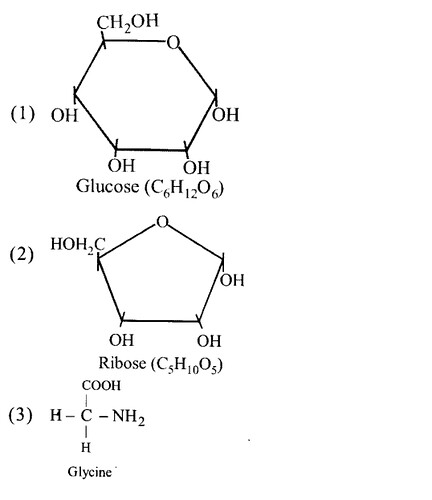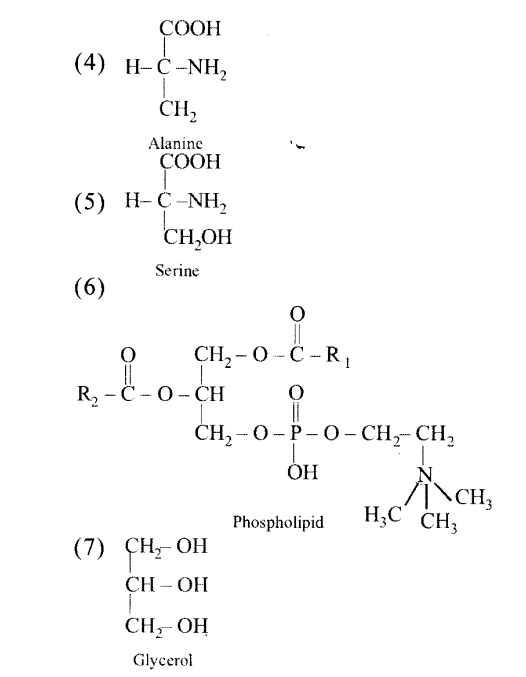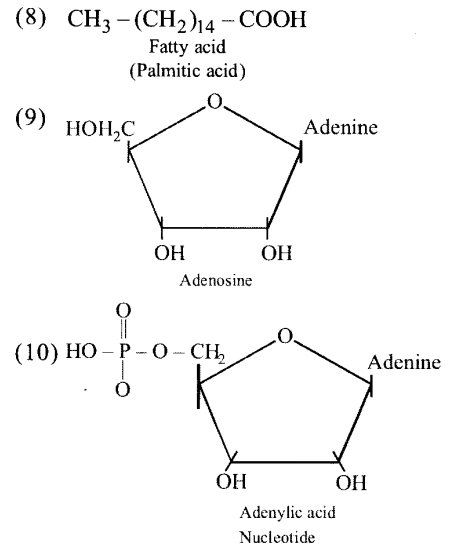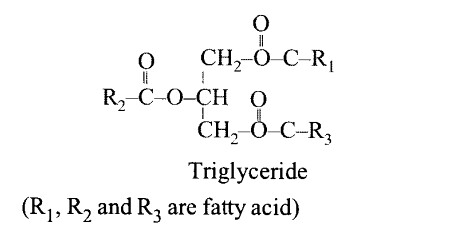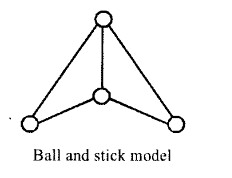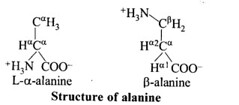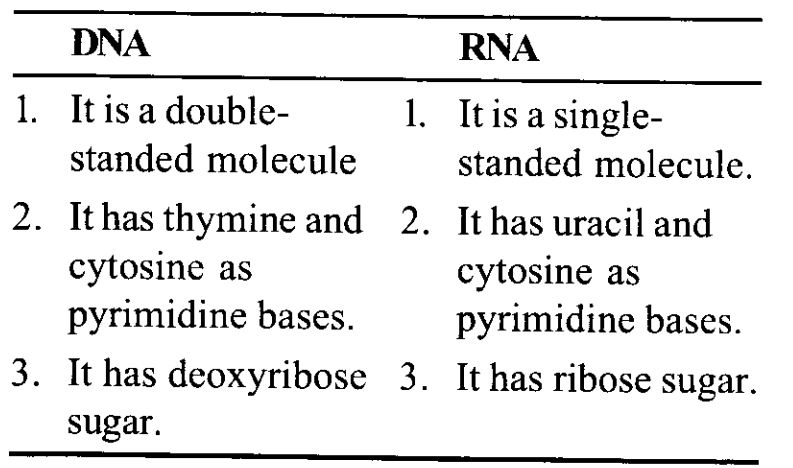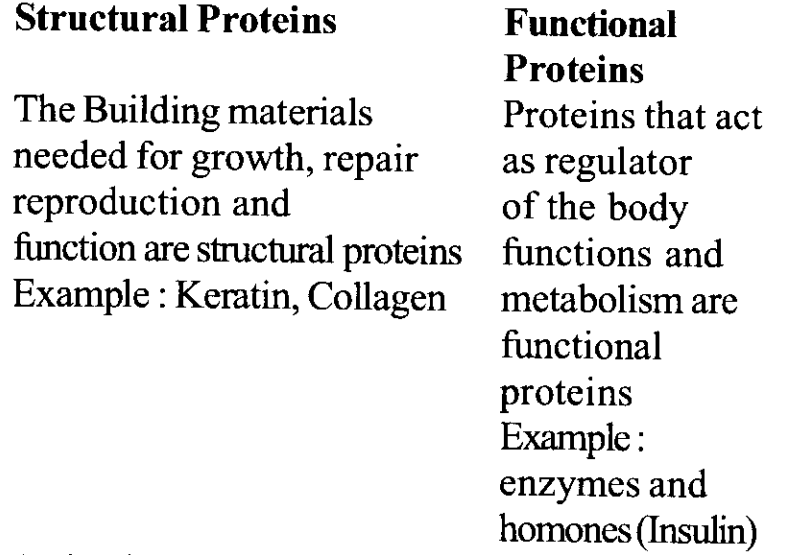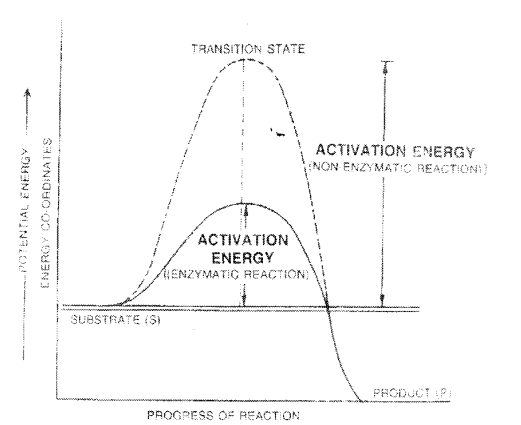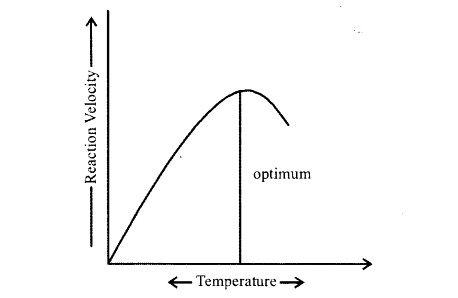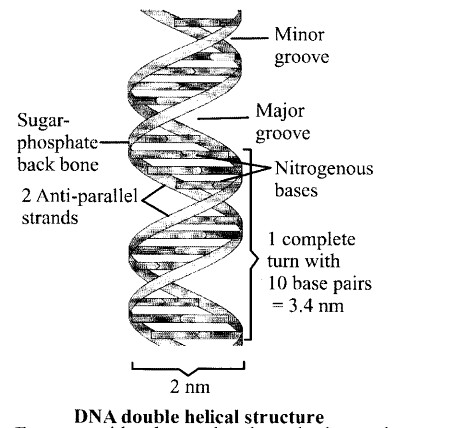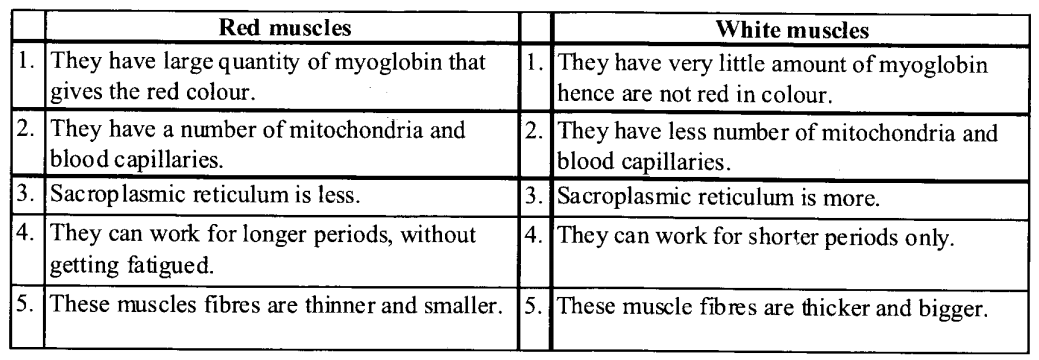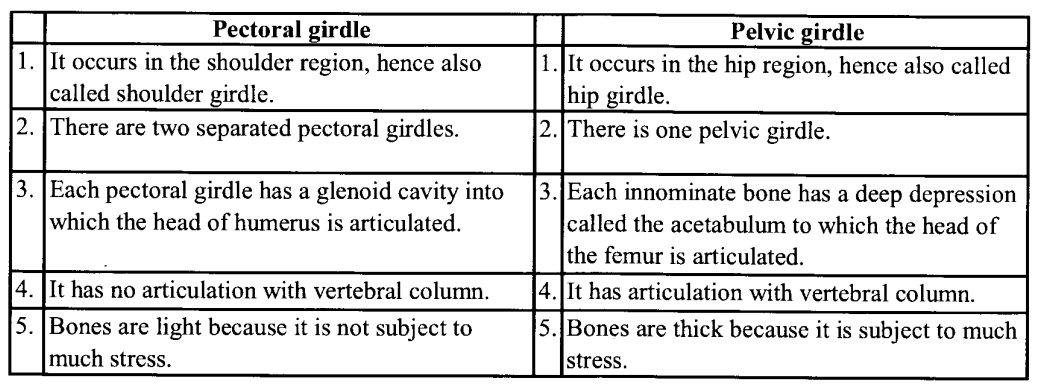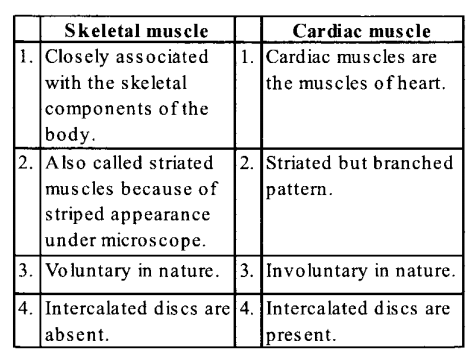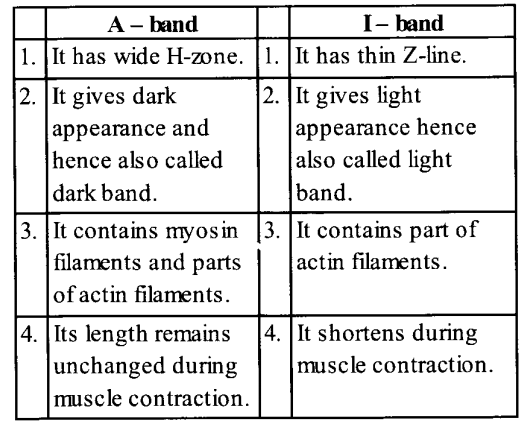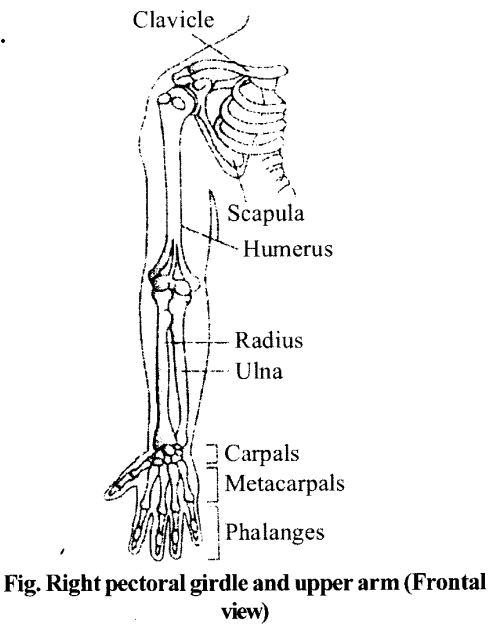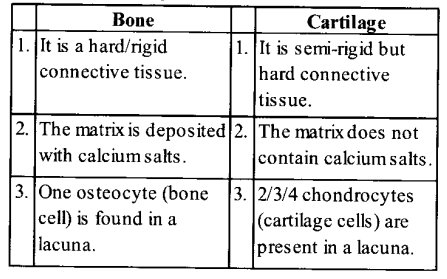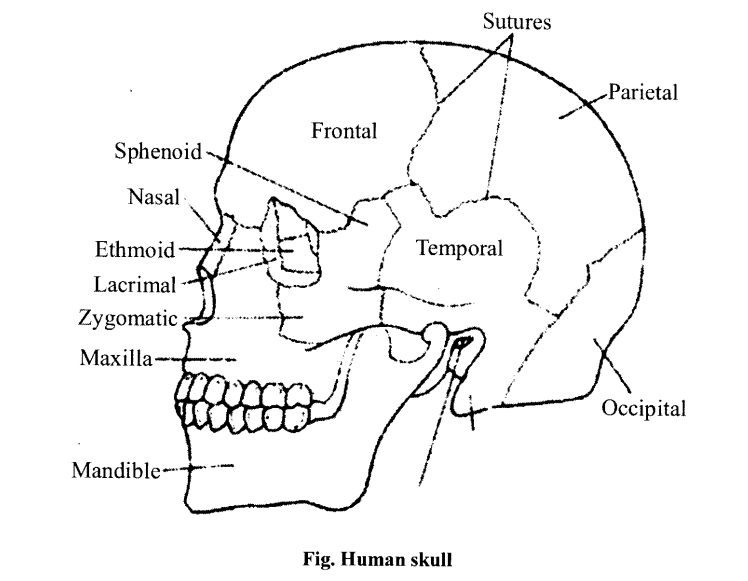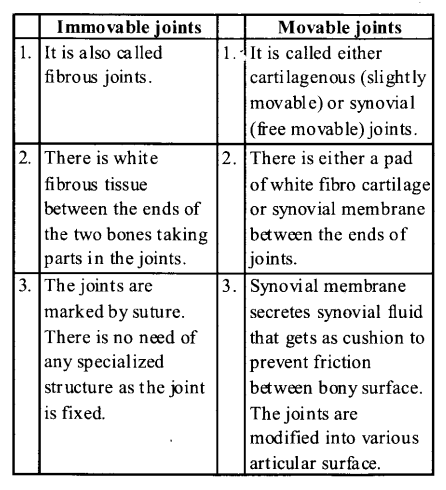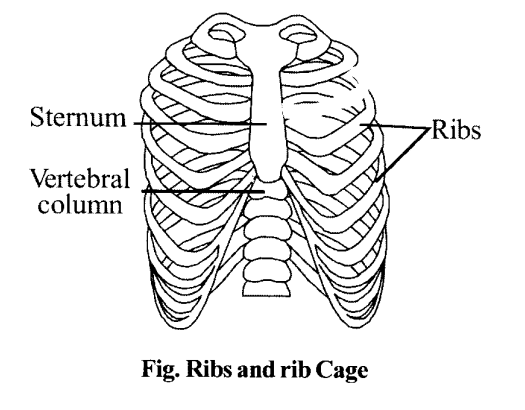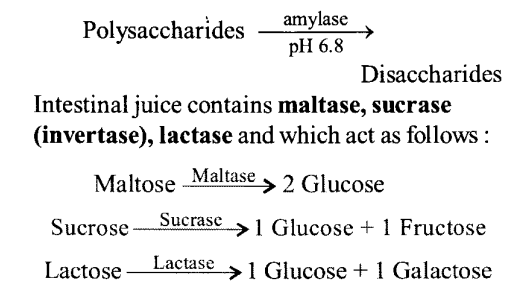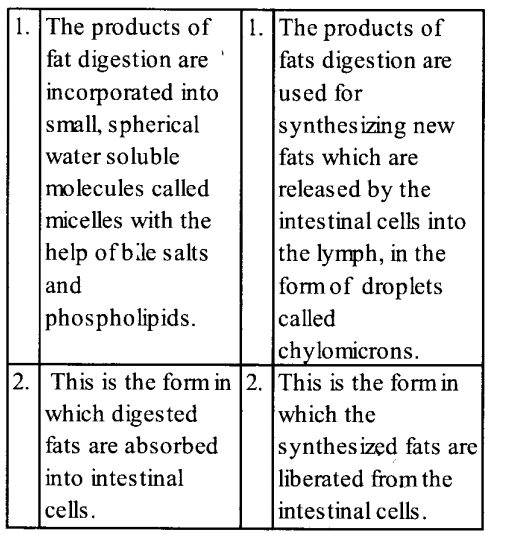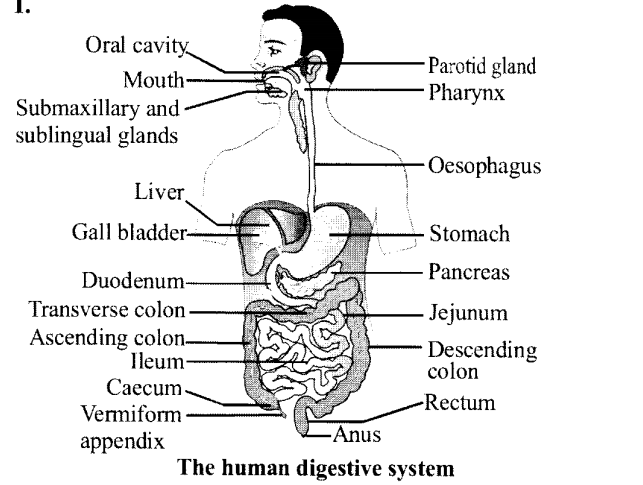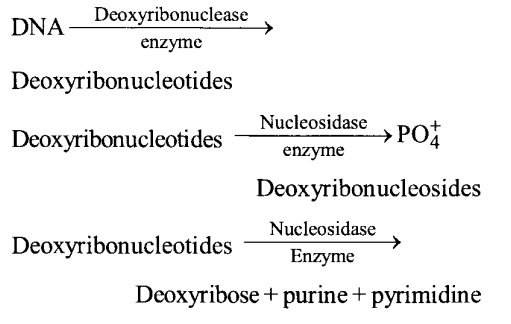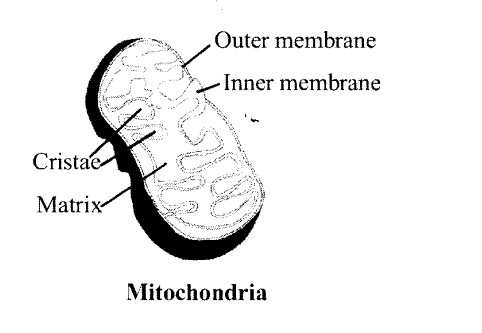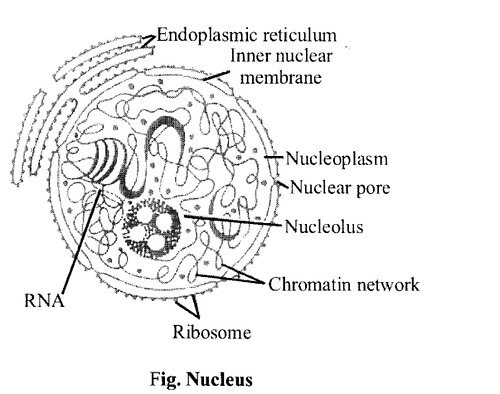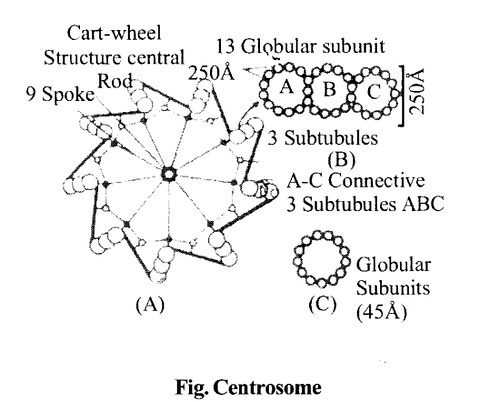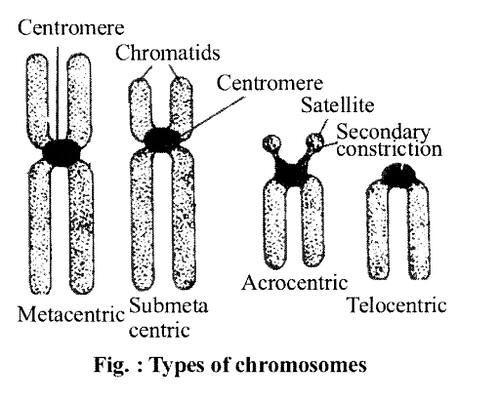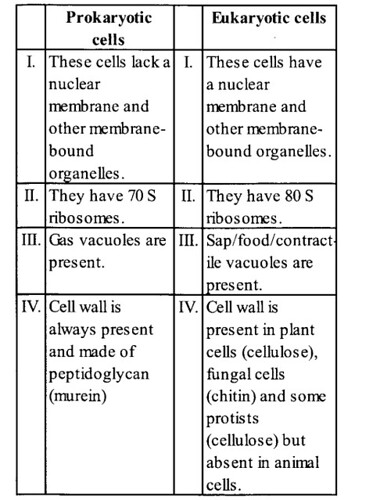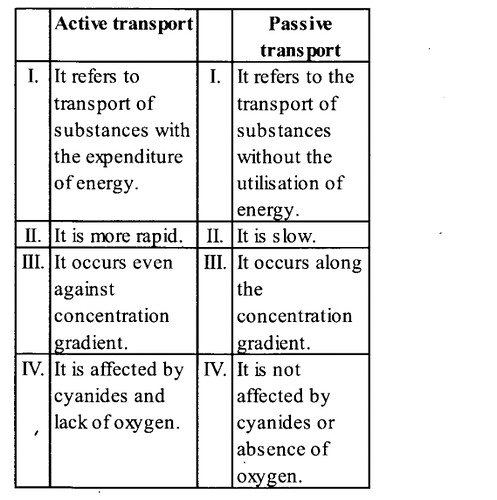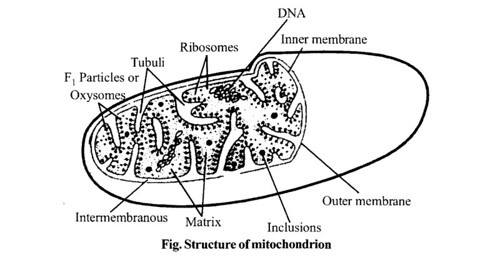NCERT Solutions for Class 11 Biology Chapter 15 Plant Growth and Development
These Solutions are part of NCERT Solutions for Class 11 Biology. Here we have given NCERT Solutions for Class 11 Biology Chapter 15 Plant Growth and Development.
Question 1.
Define growth, differentiation, development, dedifferentiation, redifferentiation, determinate growth, meristem, and growth rate.
Solution:
(1) Growth: Growth is accompanied by metabolic processes (both anabolic and catabolic), that occur at the expense of energy. For example, the expansion of a leaf is growth.
(2) Differentiation: The cells derived from root apical and shoot apical meristems and cambium differentiate and mature to perform specific functions. This act leading to maturation is termed differentiation. They undergo a few or major structural changes both in their cell walls and protoplasm. For example, to form a tracheary element, the cells would lose their protoplasm.
(3) Development: Development is a term that includes all changes that an organism goes through during its life cycle from germination of the seed to senescence. It is also applicable to tissues/organs.
(4) Dedifferentiation: Plants show another interesting phenomenon. The living differentiated cells, that by now have lost the capacity to divide can regain the capacity of the division under certain conditions. This phenomenon is termed dedifferentiation. For example, interfascicular cambium and cork cambium.
(5) Redifferentiation: While doing so, such meristems/ tissues are able to produce cells that once again lose the capacity to divide but mature to perform specific functions, i.e., get redifferentiated. List some of the tissues in a woody dicotyledonous plant that are the products of redifferentiation.
(6) Determinate growth: The growth in plants is open i.e. it can be indeterminate or determinate. Even differentiation in plants is open because cells tissues arising out of the same meristem have different structures at maturity. The final structure at maturity of a cell/’ tissue is also determined by the location of the cell within. For example, cells positioned away from root apical meristems differentiate as rootcap cells, while those pushed to the periphery mature as the epidermis.
(7) Meristem growth: The constantly dividing cells, both at the root apex and shoot apex, represent the meristematic phase of growth.
(8) Growth rate: The increased growth per unit time is termed as growth rate. Thus, the rate of growth can be expressed mathematically. An organism or a part of the organism can produce more cells in a variety of ways. The growth rate shows an increase that may be arithmetic or geometrical.
Question 2.
Why is not any one parameter good enough to demonstrate growth throughout the life of a flowering plant?
Solution:
In plants, growth is said to have taken place when the number of protoplasm increases. Measuring the growth of protoplasm involves many parameters such as weight of fresh tissue sample, the weight of dry tissue sample, differences in length, area, volume and cell number measured during the growth period. Measuring the growth of plants using only one parameter does not provide enough information and hence, is insufficient for demonstrating growth.
Question 3.
Describe briefly:
(a) Arithmetic growth
(b) Geometric growth
(c) Sigmoid growth curve
(d) Absolute and relative growth rates
Solution:
(i) Arithmetic growth: In this type of growth after mitosis, only one daughter cell continues to divide while the others take part in differentiation and maturation e.g., root elongating at constant rate. Here a ‘linear curve is obtained.
(ii) Geometric growth : In most systems, the initial growth is slow (lag phase), and it increases rapidly thereafter – at an exponential rate (log or exponential phase), Here both the progeny cells following mitotic cell division divide continuously.
(iii) Sigmoid growth curve : Sigmoid or S-shaped growth curve consists of three phases i.e., lag phase, log phase and stationary phase. During lag phase plant i growth is slow (in phase of cell division), but increases at log or exponential phase , (due to cell enlargement). During stationary phase the growth again slows down due f to the limitation of nutrients.
(iv) Absolute and relative growth rates : Measurement and comparison of total growth per unit time is called the absolute growth rate. The growth of the given system per unit time expressed on a common basis e.g., per unit initial parameter is called the relative growth rate,
Question 4.
List flve main groups of natural plant growth regulators. Write a note on discovery, physiological functions and agricultural/ horticultural applications of any one of them.
Solution:
The five main groups of natural growth regulators are
(a) auxins
(b) gibberellins
(c) cytokinins
(d) ethylene
(e) abscisic acid
Gibberellins
Discovery: – They are another kind of promotory PGR. There are more than 100 gibberellins reported from different organisms such as fungi and higher plants. They are denoted as GA1, GA2, GA3. E. Kurosawa reported the symptoms of the disease r in infected rice seedings when they were treated with filtrates of the fungus. Gibberalla fujikuroi caused, ‘bakane’ (foolish seedling) a disease of rice seedlings. The active substances were later identified as gibberellic acid.
Physiological functions
(i) They cause an increase in length of axis is used to increase the length of grapes stalk.
(ii) Gibberellins cause fruit like apple to elongate and improve its shape.
(iii) They also delay senescence. Thus the fruits can be left on the tree longer so as to extend the market period.
Agricultural Applications
(i) Spraying sugarcane crop with gibberellins increases the length of stem. Thus increasing the yield as much as 20 tonnes per acre.
(ii) Spraying juvenile conifers with GAs hastens the maturity period, thus leading to early seed production.
(iii) Gibberellins also promotes bolting (internode elongation just prior to flowering) in beet, cabbages and many plants with rosette habit.
Question 5.
What do you understand by photoperiodism and vernalisation? Describe their significance.
Solution:
Photoperiodism refers to the response of plants with respect to the duration of light. On the basis of its response to the duration of light, a plant is classified as a short-day plant, a long-day plant or a day-neutral plant. Photoperiodism helps in studying the response of flowering in various crop plants with respect to the duration of exposure to light.
Vernalisation is the cold-induced flowering in plants. In some plants, exposure to low temperatures is necessary for flowering to be induced. The winter varieties of rye and wheat are planted in autumn. They remain in the seeding stage during winters and flower during summers. However, when these varieties are sown in spring, they fail to flower.
Question 6.
Why is abscisic acid also known as stress hormone?
Solution:
Abscisic acid is known as the stress hormone because it stimulates the closure of stomata in the epidermis and increases the tolerance of plants to various kinds of stresses.
Question 7.
‘Both growth and differentiation in higher plants are open’ Comment.
Solution:
Growth and development in higher plants are referred to as being open because various meristems, having the capacity for continuously dividing and producing new cells, are present at different locations in these plant bodies.
Question 8.
‘Both a short day plant and a long day plant can flower simultaneously in a given place’. Explain.
Solution:
There are two different plants one is Oat which is a long-day plant and the other one is Xanthium which is a short-day plant. Both have different photoperiods i.e. 9 hrs in Oat and 15.6 hrs in Xanthium. At 9.5 hrs both Oat and Xanthium will be flowering simultaneously.
Question 9.
Which one of the plant growth regulators would you use if you are asked to:
(a) induce rooting in a twig
(b) quickly ripen a fruit
(c) delay leaf senescence
(d) induce growth in axillary buds
(e) ‘bolt a rosette plant’
(f) induce immediate stomatal closure in leaves.
Solution:
(a) Auxin
(b) Ethylene
(c) Cytokinin
(d) Cytokinin
(e) Gibberellin
(f) Abscisic acid
Question 10.
Would a defoliated plant respond to the photoperiodic cycle? Why?
Solution:
The flowering in certain plants depends not only on a combination of light and dark exposures but also on their relative durations. This is a photoperiodic cycle. Because, while shoot apices modify themselves into flowering apices prior to flowering, they (i.e., shoot apices of plants) by themselves cannot perceive photoperiods. The site of perception of light/ dark duration is the leaves. It has been hypothesized that there is a hormonal substance(s) called florigen that is responsible for flowering. Florigen migrates from leaves to shoot apices for inducing flowering only when the plants are exposed to the necessary inductive photoperiod.
Question 11.
What would be expected to happen if:
(a) GA3 is applied to rice seedlings
(b) dividing cells stop differentiating
(c) a rotten fruit gets mixed with unripe fruits
(d) you forget to add cytokinin to the culture medium.
Solution:
(a) It causes elongation of stems and leaf sheaths.
(b) A callus of the undifferentiated cells will be produced.
(c) It stimulates the ripening of unripe fruits.
(d) It inhibits the growth of callus.
VERY SHORT ANSWER QUESTIONS
Question 1.
What is the full form of IAA?
Solution:
Indole acetic acid
Question 2.
Name the apparatus used In determining growth in the plant? (Oct. 85)
Solution:
Auxanometer
Question 3.
Name stress hormone in plants that functions during drought.
Solution:
Abscisic acid
Question 4.
Name the hormone that makes the plant more tolerant to various stresses.
Solution:
Abscisic acid
Question 5.
In a wheat field, some broad-leaved weeds were seen by a farmer. Which plant hormone would you suggest to get rid of them?
Solution:
2,4-dichloro phenoxy acetic acid (2,4-D)
Question 6.
A farmer grows cucumber plants in his field. He wants to increase the number of female flowers in them. Which plant growth regulator can be applied to achieve this?
Solution:
Ethylene
Question 7.
What is the result of the addition of gibberellins to plants? (Oct. 91)
Solution:
Bolting
Question 8.
Define growth rate.
Solution:
The increased growth per unit time is called a growth rate.
Question 9.
Who isolated auxin? Name the plant source.
Solution:
F. W. Went isolated auxin. He isolated it from tips of coleoptiles of oat seedlings.
Question 10.
Define photoperiodism. (Apr. 97)
Solution:
The response of a plant to varying photoperiods of light is called photoperiodism.
Question 11.
Name the causative agent of ‘bakane’ disease in rice seedlings.
Solution:
Gibberella fujikuroi
Question 12.
Define climacteric.
Solution:
Climacteric refers to the increased rate of respiration during the ripening of fruits.
Question 13.
What would happen when a branch from a short day plant after floral induction is grafted on a non-induced long day plant?
Solution:
The long day plant would start flowering because a short day plant is capable to induce flowering in the long-day plant.
Question 14.
What is the most abundant natural cytokinin that was isolated from com kernels and coconut milk?
Solution:
Zeatin is the most abundant natural Cytokinin that was isolated from com Kernels and Coconut milk
Question 15.
Which, plant hormone was first isolated from human urine?
Solution:
Auxin was first isolated from human urine.
SHORT ANSWER QUESTIONS
Question 1.
List some structural modifications which occur during cell differentiation.
Solution:
During differentiation, cells undergo few to major structural changes both in their cell walls and
protoplasm. For example, to form a tracheary element, the cells would lose their protoplasm. They also develop very strong, elastic, lignocellulosic secondary cell walls, to carry water to long distances even under extreme conditions.
Question 2.
How do you induce lateral branching in a plant which normally does not produce them? Give reasons in support of your answer.
Solution:
Apical bud checks the sprouting of lateral buds due to the presence of auxins. When the apical bud is removed, lateral branches are produced. Due to the removal of apical bud effect of auxins is destroyed inducing the lateral buds to grow rapidly.
Question 3.
Define growth regulators.
Solution:
The plant growth regulators (PGRs) are small, simple molecules of diverse chemical
composition. They could be indole compounds (indole-3-acetic acid, IAA); adenine derivatives (kinetin), derivatives of carotenoids (abscisic acid, ABA); terpenes (gibberellic acid, GA3) or gases (ethylene, C2H4). Plant growth regulators are variously described as plant growth substances, plant hormones or phytohormones.
Question 4.
Define the term Growth. Mention the phases of growth. (Oct. 1988, 2000, 2003, July 2006, March 2011)
Solution:
Growth is a permanent irreversible change brought about by an increase in size, weight or volume. The phases of growth are
- Phase of cell division or formation
- Phase of cell elongation or enlargement
- Phase of cell maturation or differentiation.
Question 5.
Define plasticity.
Solution:
Plants follow different pathways in response to the environment or phases of life. It leads to formation of different structures. This ability is called plasticity.
Question 6.
What is growth? How will you measure the rate of growth?
Solution:
- Growth is defined as a permanent or irreversible increase in dry weight, size, mass or volume of a cell, organ or organism.
- Generally growth is accompanied by metabolic processes (both anabolic and catabolic). At the cellular level, growth is due to increase in amount of protoplasm.
- However, it is difficult to measure increase in protoplasm.
- Increase in protoplasm leads to increase in cell, cell number and cell size. This fact is used in calculating growth which, therefore, is a quantitive or measurable phenomenon.
- The parameters used for measuring growth increase in fresh weight, dry weight, length, area, volume and cell number.
Question 7.
Explain the different phases of growth with the help of a diagram.
Solution:
The period of growth is generally divided into three phases – meristematic, elongation, and maturation.
Meristematic phase: The constantly dividing cells, both at the root apex and the shoot apex, represent the meristematic phase of growth. The cells in this region are rich in protoplasm possess large conspicuous nuclei.
Their cell walls are primary in nature, thin, and cellulosic with abundant plasmodesmatal connections.
Elongation phase: The cells proximal to the meristematic zone represent the phase of elongation.
Increased vacuolation, cell enlargement, and new cell wall deposition are the characteristics of the cells in this phase.
Maturation phase: The cells of this zone, attain their maximal size in terms of wall thickening and protoplasmic modifications.

Question 8.
Define growth and describe the three phases of growth. (Oct. 83, 85)
Solution:
Growth is a permanent irreversible change brought about by an increase in height, weight, or volume. The three phases of growth are;
(a) Phase of cell division or cell formation:
This region is located at the tip of shoot and root. It is represented by the apical meristem capable of rapid cell division. The cells are undifferentiated, with a thin cell wall made of cellulose, with an active protoplasm and prominent nucleus. This region is mainly concerned with cell division.
(b) Phase of cell elongation or cell enlargement: This region lies next to the cell formation zone. The cells enlarge because of their elastic cell walls. Growth takes place during this stage either by apposition or intussusception. Cells are turgid.
(c) Phase of cell differentiation or cell maturation: This represents the last region and differentiation based on functions is seen here. Secondary walls are laid down where some have additional deposits of lignin, Suberin, and others lose their protoplast and become dead.
Question 9.
Where are auxins synthesized in plants? Mention any two of their functions.
Solution:
Auxins are produced in the growing shoot apices and root apices.
Functions of auxins are as follows :
(i) Auxins control apical dominance, i.e., they suppress the growth of lateral buds into branches.
(ii) They help to prevent fruit and leaf drop at early stages but promote the abscission of older mature leaves and fruits.
Question 10.
Where are cytokinins synthesised in plants? Mention any two of their functions.
Solution:
Cytokinins are synthesised in plant parts where rapid cell division occurs, like root apices, shoot buds, young fruits, etc. The functions of cytokines are as follows:
(i) Cytokinins influence cell division (cytokinesis), cell enlargement and differentiation.
Question 11.
Explain apical dominance. Name the hormone that controls it.
Solution:
Apical dominance is the phenomenon in which the apical bud suppresses the growth of lateral buds into branches. Auxin is the hormone that controls it.
Question 12.
How does abscisic acid act antagonistically to auxins and gibberellins?
Solution:
ABA induces the formation of the abscission layer, while auxins prevent the formation of the abscission layer.
ABA induces seed dormancy and bud dormancy, while gibberellins break seed dormancy and bud dormancy.
Question 13.
What is ethephon? How does it function in plants? Give any two of its functions.
Solution:
Ethephon:
- It is a compound used as a source of ethylene for plant growth.
- It is an aqueous solution that is easily absorbed by the plants and transported within the plant.
- It releases ethylene slowly.
Functions of ethephon are as follows:
- It accelerates abscission in flowers and thinning in cotton, walnut, and cherry, etc.
- It promotes the development of female flowers in cucumbers thereby increasing the yield.
Question 14.
Discuss the practical applications of auxins in Agriculture and Horticulture. (Oct. 96) OR What are auxins? Explain briefly uses of Auxins. (Oct. 99)
Solution:
Auxins are a group of plant growth substances, acidic in nature and bring about over-all growth.
- Apical dominance: As long as the apical bud is present growth of lateral buds is pre-vented which is used in the long term storage of potato tubers.
- Rooting: In low concentrations, auxins stimulate root formation which is used to propagate cuttings. When dipped in a dilute solution of auxins the root formation is initiated.
- Flower initiation: Low Concentration of 2, 4-D and NAA are used to initiate flowering in a pineapple so that harvesting becomes easy.
- Abscission: Application of auxins increase the concentration and thereby delays the development of abscission which prevents premature leaf and fruitful. This is used in orchards and prevention of defoliation in cabbages and cauliflower.
- Parthenocarpy: This is the process of obtaining fruits without fertilization and gives rise to seedless varieties which is successfully used in citrus, dates.
- Sex expression: Use of auxins on cucurbit plants increases the production of female flower.
- Weedicide / Herbicide: 2-4-D is widely used as a herbicide on broad-leaved forms because of its non-toxic nature. Widely used in crop plant cultivation or lawns.
- Tissue culture (organogenesis): In tissue culture where micropropagation is carried out the auxins are used to bring about organogenesis.
Question 15.
Differentiate between phototropism and Geotropism.
Solution:
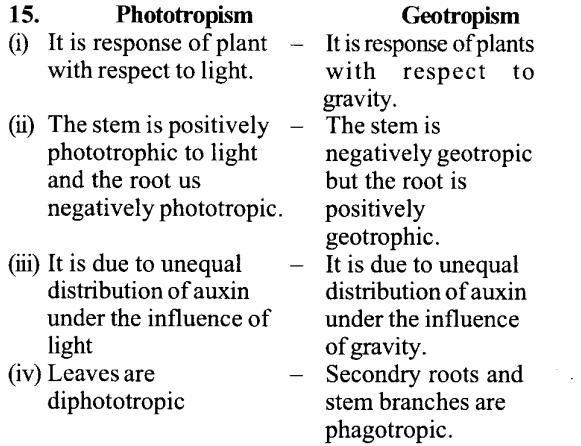
Question 16.
What are Terpenoids?
Solution:
Terpenoids are derivatives of terpenes, includes abscisic acid and gibberellin and the carotenoid and chlorophyll pigments.
LONG ANSWER QUESTIONS
Question 1.
What is meant by vernalization? Explain the significance of vernalization.
Solution:
- Vernalization may be defined as the method of inducing early flowering in plants by pretreatment of their seeds at low temperatures.
- It is the acquisition or acceleration of the ability to flower by chilling treatment.
- Some cereals such as wheat, barley, oat and rye have two kinds of varieties: winter and spring varieties.
- The ‘spring’ variety are normally planted in the spring and come to flower and produce grain before the end of the growing season.
- Winter varieties, however, if planted in spring would normally fail to flower or produce mature grain within a span of a flowering season.
- Hence, they are planted in autumn. They germinate, and during winter come out as small seedling, resume growth in the spring, and are harvested usually around mid-summer.
- Another example of vernalization is seen in biennial plants. Biennials are monocarpic plants that normally flower and die in the second season. Sugarbeet, cabbages, carrots are some of the common biennials.
- Subj ecting the growing of a biennial plant to a cold treatment stimulates a subsequent photoperiodic flowering response.
The significance of vernalization is as follows:
- It reduces the vegetative period of the plant.
- It prepares the plants for flowering.
- It increases yield, resistance to cold and diseases.
- Vernalization is beneficial in reducing the period between germination and flowering.
Thus, more than one crop can be obtained during a year.
Question 2.
Discuss the role of auxins in plant growth.
OR
Describe any four physiological effects of auxins. (Oct. 89, 2001)
Solution:
- Cell division and Differentiation: Auxins promote cell division and their subsequent differentiation into tissues. They are used in cultures to bring about organogenesis.
- Apical dominance: Auxins are more concentrated in the terminal buds rather than lateral buds. Therefore the presence of the terminal buds inhibits the growth of lateral buds which is also true when auxins are applied to the cut surface of the stem. This is used in preventing the sprouting of potato buds (axillary buds).
- Root Initiation: Low concentrations of auxins promote rooting which can propagate more plants vegetatively.
- Abscission formation: The development of abscission is due to a decrease in auxin concentration resulting in fruit fall and defoliation. In young leaves and fruits, the concentration is high. Hence the external application of auxins helps to prevent premature fruit drop of apple, pear, and defoliation of cabbage.
- Parthenocarpy: A normal fruit develops after fertilization, during which the auxin concentration increases. The application of auxins stimulates fruit formation without fertilization and is called parthenocarpy.
- Herbicide: Synthetic auxins like 2, 4 – D and 2, 4, 5-T are toxic to broad-leaved plants and because of this used as selective herbicides in crop plants, lawn grass, etc.
Question 3.
What is meant by seed dormancy? Describe the methods to overcome seed dormancy.
Solution:
Seed dormancy
- There are certain seeds which fail to germinate even when external conditions are favourable. Such seeds are undergoing a period of dormancy which is controlled not by the external environment but are under endogenous control or conditions within the seed itself.
- Impermeable and hard seed coat; the presence of chemical inhibitors such as abscisic acids, phenolic acids, para-ascorbic acid; and immature embryos are some of the reasons which cause seed dormancy.
- Seed dormancy, however, can be overcome through natural means and various other means e.g. the seed coat barrier in some seeds can be broken by mechanical abrasions using knives, sandpaper, etc. or vigorous shaking. In nature, these abrasions are caused by microbial action, and passage through the digestive tract of animals.
- The effect of inhibitory substances can be removed by subjecting the seeds to chilling conditions or by application of certain chemicals like gibberellic acid and nitrates.
- Changing the environmental conditions, such as light and temperature are other methods to overcome seed dormancy.
Question 4.
Describe the phenomenon of photoperiodism.
Solution:
The effect of photoperiods or day duration of light hours (and dark periods) on the growth and development of plants, especially flowering, is called photoperiodism. On the basis of photoperiodic response to flowering, plants have been divided into the following categories:
- Short-day plants: They flower when the photoperiod or day length is below a critical period. Most winter flowering plants belong to this category, e.g., Xanthium, Chrysanthemum, rice, sugarcane, etc.
- Long-day plants: These plants flower when they receive long photoperiods or light hours which are above a critical length, e.g., wheat, oat, sugar beet, spinach, radish, barley, etc.
- Day-neutral plants: There are many plants, however, where there is no such correlation between exposure to the light duration and induction of flowering response; such plants are called day-neutral plants e.g. tomato, cucumber, etc.
We hope the NCERT Solutions for Class 11 Biology at Work Chapter 15 Plant Growth And Development, help you. If you have any query regarding NCERT Solutions for Class 11 Biology at Work Chapter 15 Plant Growth And Development, drop a comment below and we will get back to you at the earliest.

